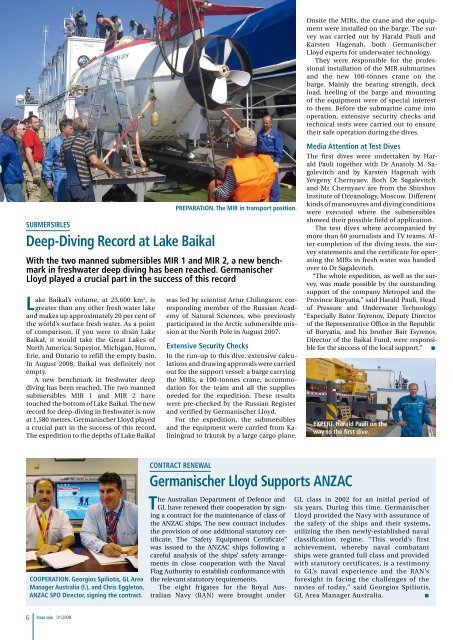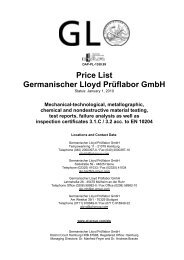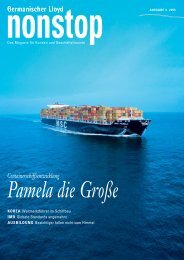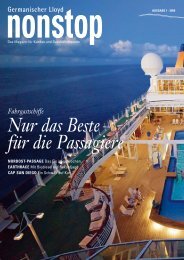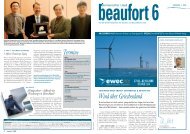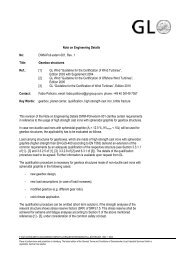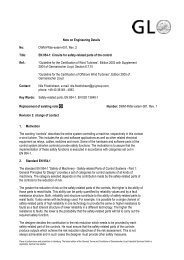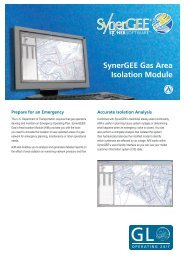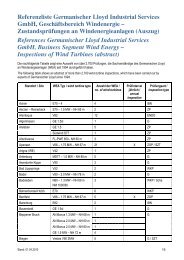bravo zulu 1/2008 - GL Group
bravo zulu 1/2008 - GL Group
bravo zulu 1/2008 - GL Group
Create successful ePaper yourself
Turn your PDF publications into a flip-book with our unique Google optimized e-Paper software.
SUBmERSIBlES<br />
deep-diving Record at lake Baikal<br />
With the two manned submersibles mIR 1 and mIR 2, a new benchmark<br />
in freshwater deep diving has been reached. germanischer<br />
lloyd played a crucial part in the success of this record<br />
lake Baikal’s volume, at 23,600 km3 , is<br />
greater than any other fresh water lake<br />
and makes up approximately 20 per cent of<br />
the world’s surface fresh water. As a point<br />
of comparison, if you were to drain Lake<br />
Baikal, it would take the Great Lakes of<br />
North America: Superior, Michigan, Huron,<br />
Erie, and Ontario to refill the empty basin.<br />
In August <strong>2008</strong>, Baikal was definitely not<br />
empty.<br />
A new benchmark in freshwater deep<br />
diving has been reached. The two manned<br />
submersibles MIR 1 and MIR 2 have<br />
touched the bottom of Lake Baikal. The new<br />
record for deep-diving in freshwater is now<br />
at 1,580 metres. Germanischer Lloyd played<br />
a crucial part in the success of this record.<br />
The expedition to the depths of Lake Baikal<br />
6<br />
coopERaTIon. georgios Spiliotis, gl area<br />
manager australia (l.), and chris Eggleton,<br />
anZac Spo director, signing the contract.<br />
<strong>bravo</strong> <strong>zulu</strong> 01/<strong>2008</strong><br />
pREpaRaTIon. The mIR in transport position.<br />
was led by scientist Artur Chilingarov, corresponding<br />
member of the Russian Academy<br />
of Natural Sciences, who previously<br />
participated in the Arctic submersible mission<br />
at the North Pole in August 2007.<br />
Extensive Security checks<br />
In the run-up to this dive, extensive calculations<br />
and drawing approvals were carried<br />
out for the support vessel: a barge carrying<br />
the MIRs, a 100-tonnes crane, accommodation<br />
for the team and all the supplies<br />
needed for the expedition. These results<br />
were pre-checked by the Russian Register<br />
and verified by Germanischer Lloyd.<br />
For the expedition, the submersibles<br />
and the equipment were carried from Kaliningrad<br />
to Irkutsk by a large cargo plane.<br />
The Australian Department of Defence and<br />
<strong>GL</strong> have renewed their cooperation by signing<br />
a contract for the maintenance of class of<br />
the ANZAC ships. The new contract includes<br />
the provision of one additional statutory certificate.<br />
The “Safety Equipment Certificate”<br />
was issued to the ANZAC ships following a<br />
careful analysis of the ships’ safety arrangements<br />
in close cooperation with the Naval<br />
Flag Authority to establish conformance with<br />
the relevant statutory requirements.<br />
The eight frigates for the Royal Australian<br />
Navy (RAN) were brought under<br />
Onsite the MIRs, the crane and the equipment<br />
were installed on the barge. The survey<br />
was carried out by Harald Pauli and<br />
Karsten Hagenah, both Germanischer<br />
Lloyd experts for underwater technology.<br />
They were responsible for the professional<br />
installation of the MIR submarines<br />
and the new 100-tonnes crane on the<br />
barge. Mainly the bearing strength, deck<br />
load, heeling of the barge and mounting<br />
of the equipment were of special interest<br />
to them. Before the submarine came into<br />
operation, extensive security checks and<br />
technical tests were carried out to ensure<br />
their safe operation during the dives.<br />
media attention at Test dives<br />
The first dives were undertaken by Harald<br />
Pauli together with Dr Anatoly M. Sagalevitch<br />
and by Karsten Hagenah with<br />
Yevgeny Chernyaev. Both Dr Sagalevitch<br />
and Mr Chernyaev are from the Shirshov<br />
Institute of Oceanology, Moscow. Different<br />
kinds of manoeuvres and diving conditions<br />
were executed where the submersibles<br />
showed their possible field of application.<br />
The test dives where accompanied by<br />
more than 60 journalists and TV teams. After<br />
completion of the diving tests, the survey<br />
statements and the certificate for operating<br />
the MIRs in fresh water was handed<br />
over to Dr Sagalevitch.<br />
“The whole expedition, as well as the survey,<br />
was made possible by the outstanding<br />
support of the company Metropol and the<br />
Province Buryatia,” said Harald Pauli, Head<br />
of Pressure and Underwater Technology.<br />
“Especially Bator Tsyrenov, Deputy Director<br />
of the Representative Office in the Republic<br />
of Buryatia, and his brother Bair Tsyrenov,<br />
Director of the Baikal Fund, were responsible<br />
for the success of the local support.” ■<br />
EXpERT. harald pauli on the<br />
way to the first dive.<br />
conTRacT REnEWal<br />
germanischer lloyd Supports anZac<br />
<strong>GL</strong> class in 2002 for an initial period of<br />
six years. During this time, Germanischer<br />
Lloyd provided the Navy with assurance of<br />
the safety of the ships and their systems,<br />
utilizing the then newly-established naval<br />
classification regime. “This world’s first<br />
achievement, whereby naval combatant<br />
ships were granted full class and provided<br />
with statutory certificates, is a testimony<br />
to <strong>GL</strong>’s naval experience and the RAN’s<br />
foresight in facing the challenges of the<br />
navies of today,” said Georgios Spiliotis,<br />
<strong>GL</strong> Area Manager Australia. ■


